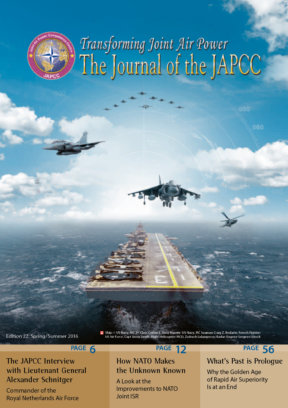Introduction
Since the United States began worldwide military operations in response to the 11 September 2001 terrorist attacks, our military has been increasingly tasked to fight Violent Extremist Organizations (VEO).1 Wars in Afghanistan and Iraq, characterized by large, conventional troop mobilizations and nation-building exercises, have been inconclusive. Recent hostilities in Mali, Yemen, Syria, and Libya have joined long-simmering conflicts in Somalia and Pakistan as VEO influence spreads.2 As more countries became battlefields, US tactics shifted away from massive and costly deployments towards air strikes of key enemy personnel. Three factors have converged, creating an environment ripe for NATO Special Operations Forces (SOF) involvement in efforts similar to the US SOF High Value Individual (HVI) air strike campaign.
First, the continued refinement of the US find, fix, and finish targeting methodology has demonstrated VEO HVIs can be struck worldwide with minimal collateral damage.3 Second, striking terrorist leadership remains politically palatable, and precision engagement of HVIs has proven politically popular.4 Lastly, mass casualty attacks in Paris combined with public declarations by VEOs reaffirming their commitment to attack NATO countries increases political pressure to act. These factors create the potential for NATO SOF to augment ongoing US SOF operations targeting VEO HVIs. If that happens, three lessons from the US effort should be internalized by NATO leadership at the outset.
Manage Expectations
HVI air strikes alone will not defeat VEOs under most circumstances, and decapitation strategies will not stop ideologies.5 This does not mean air strikes are futile. It simply means SOF leadership must engage in critical rather than wishful thinking regarding benefits and limitations before advocating an HVI air strike campaign. ‘Battles are dangerous affairs’6 is the ancient acknowledgement that violence is inherently unpredictable, precipitating intended results but also unintended consequences. Although proficiency at HVI air strikes is better than ever, SOF leadership must manage political and military expectations about positive, negative, and unknown aspects of a HVI air strike approach to VEOs.
The US campaign, although indecisive against VEOs, has nevertheless produced successful aspects. Air strikes have denied the enemy sanctuary by forcing them to re-evaluate areas previously considered safe from US attack.7 Since the opening salvos against Taliban targets during the early days of Operation ENDURING FREEDOM, airpower has been the asymmetric advantage of US SOF, depriving VEOs of safe havens.8 Former US Secretary of Defence Leon Panetta even called this campaign ‘the only game in town’ in terms of directly confronting al-Qaeda.9 Air strikes put VEOs on the defensive by keeping enemy HVIs occupied with force protection and evasion concerns. Alone, precision air strikes will not defeat VEOs, but strikes disrupt their offensive planning while buying space and time for other solutions. In Somalia, SOF air strikes combined with regional, conventional forces collapsed al Shabaab’s hold on massive swaths of territory. While these positive outcomes were intentionally designed, commanders must be aware of potential undesired second order effects.
US SOF rapidly killed successive al-Qaeda in Iraq (AQI) leadership, creating an impression their organization was reeling. Unfortunately, the tactically successful killings failed strategically by enabling an exceptionally capable junior member to rapidly rise in authority and rejuvenate AQI. Abu Bakr al Baghdadi transformed AQI into the Islamic State of Iraq and al Sham (ISIS) and birthed a nightmare of regional conflagration.10 The applicable lesson from ISIS is we should not presume our enemy is defeated when their leaders are killed, nor should we discount the danger of unintended consequences. Uncertainty will remain a combat variable no matter how modern our methods. NATO SOF leaders should approach any HVI campaign with clear expectations about benefits and limitations of this course of action along with a healthy respect for the unknown.
Share Information
The US has experienced mission-degrading bureaucratic friction during its SOF-led HVI air strike campaign. Coordination between disparate communities has been hampered by cultural, process, and personality differences. For precision HVI strikes to succeed, robust integration between operations and intelligence organizations is required. US military and intelligence agencies have shown a willingness to cooperate, but nonetheless challenges have surfaced.11 Within the Joint SOF community, integration has not been seamless12 and, even within the same service process, issues between operations, intelligence, and decision-makers have presented obstacles to mission success.13 As US forces have worked through much of the friction over the past decade, NATO SOF can still learn from their growing pains.
One of the most difficult obstacles faced by US forces was enabling the timely sharing of relevant information across communities. Sensor operators, intelligence analysts, interagency partners, military commanders, and civilian leaders each see information relevant to others but regulations prohibit unrestricted sharing. These restrictions make sense; information compartmentalization remains an effective means of protecting secrets. The easiest answer is only sharing minimal amounts of information at the moment it is required; however, if everyone operates this way, the paradoxical impossibility of progress soon appears. After all, if organizations only share the minimum necessary, how do they judge what amount is necessary to share without knowing more about other organization than they allow them to know about themselves? The desire to protect sources, methods, and capabilities between US government agencies and branches will become exponentially more complex if the players are NATO states, each of which must share and protect information internally within their own systems.
US SOF has not resolved this problem entirely, but friction has been decreased by using liaison officers (LNO). If properly educated on both the parent and host organization capabilities and needs, LNOs can ensure the right information is punctually shared while simultaneously protecting it from unauthorized release. The US has expanded this concept with the Joint Interagency Task Force (JIATF) construct, which is partially designed to produce the LNO function on a macro scale. Like every bureaucratic function, the LNO and JIATF constructs must be constantly managed and will not produce the desired results merely by existing. However, these organizational solutions have made the US SOF HVI campaign more lethal and should be examined by NATO SOF.
Practise
The single most important factor that increased the success of SOF air strikes during the past decade was practise. The investment in realistic practise has been instrumental in increasing the lethality of the SOF HVI air strike campaign. Seemingly simple in concept, it took a high number of failed air strikes14 to realize ‘practise’ applies not just to the tactical weapons release but is a rehearsal of the entire enterprise’s ability to communicate and make decisions fast enough to exploit fleeting windows of HVI vulnerability. Often the strike assets were ready, but decisions could not be made quickly enough to approve a strike and the opportunity passed, leaving operators frustrated with the bureaucracy. Other times, the intelligence and decision-making processes were robust, but operators failed in simply keeping crosshairs on target, leaving headquarters frustrated with inadequacies in execution. Commanders overcame these challenges by encouraging the entire team to practise both together and separately. This is difficult in a joint environment and will be doubly difficult between countries, but there is no escaping the reality that only by practising what you expect to do can you become good at doing it.
Practise is time consuming and time spent practising is time not spent tracking and gathering intelligence. Striking the right balance between practice and intelligence collection is not a stagnant formula; commanders must assess each function of their joint team to determine the appropriate ratio given situation-specific peculiarities. Knowing such a ratio exists and will be deceptively difficult to ascertain is a relevant lesson NATO SOF should extract from the US SOF HVI campaign. Commanders should strive for intimate familiarity with every function contributing to the HVI air strike enterprise and then exercise those functions as often as possible.
Final Thoughts
US SOF will likely continue to utilize precision air strikes of HVIs as a primary tool against VEOs. Alone, this will not create victory, and we are losing across the board to our adversaries.15 Nevertheless this tactic has proven politically popular and sustainable for US forces; until a winning strategy emerges, US SOF will continue to refine precision air strike methods. Consequently, examination of our techniques and polishing of best practices is the duty of officers knowledgeable about the enterprise. If NATO responds to VEO attacks by either assisting the US SOF expansion of our HVI hunt or mirroring similar practises, there are lessons learned NATO SOF members can derive from the US experience. Chief among these are expectation management regarding the efficacy and outcomes of air strikes, early streamlining of information sharing, and the importance of constant, realistic practise for the entire team.









